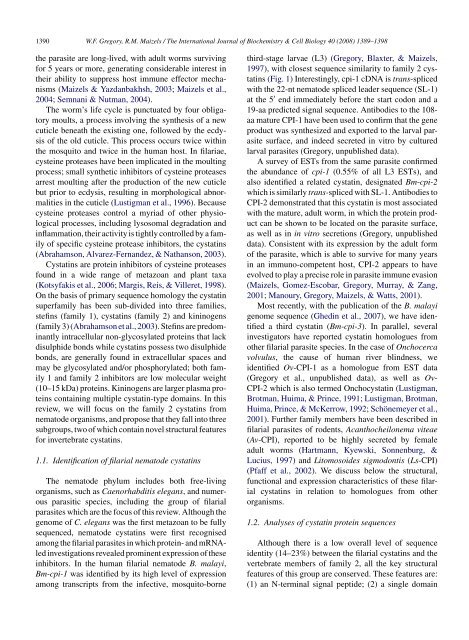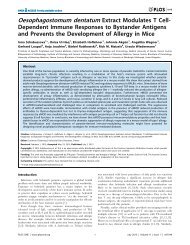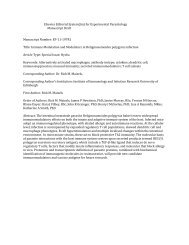Cystatins from filarial parasites - Rick Maizels' Group - University of ...
Cystatins from filarial parasites - Rick Maizels' Group - University of ...
Cystatins from filarial parasites - Rick Maizels' Group - University of ...
Create successful ePaper yourself
Turn your PDF publications into a flip-book with our unique Google optimized e-Paper software.
1390 W.F. Gregory, R.M. Maizels / The International Journal <strong>of</strong> Biochemistry & Cell Biology 40 (2008) 1389–1398<br />
the parasite are long-lived, with adult worms surviving<br />
for 5 years or more, generating considerable interest in<br />
their ability to suppress host immune effector mechanisms<br />
(Maizels & Yazdanbakhsh, 2003; Maizels et al.,<br />
2004; Semnani & Nutman, 2004).<br />
The worm’s life cycle is punctuated by four obligatory<br />
moults, a process involving the synthesis <strong>of</strong> a new<br />
cuticle beneath the existing one, followed by the ecdysis<br />
<strong>of</strong> the old cuticle. This process occurs twice within<br />
the mosquito and twice in the human host. In filariae,<br />
cysteine proteases have been implicated in the moulting<br />
process; small synthetic inhibitors <strong>of</strong> cysteine proteases<br />
arrest moulting after the production <strong>of</strong> the new cuticle<br />
but prior to ecdysis, resulting in morphological abnormalities<br />
in the cuticle (Lustigman et al., 1996). Because<br />
cysteine proteases control a myriad <strong>of</strong> other physiological<br />
processes, including lysosomal degradation and<br />
inflammation, their activity is tightly controlled by a family<br />
<strong>of</strong> specific cysteine protease inhibitors, the cystatins<br />
(Abrahamson, Alvarez-Fernandez, & Nathanson, 2003).<br />
<strong>Cystatins</strong> are protein inhibitors <strong>of</strong> cysteine proteases<br />
found in a wide range <strong>of</strong> metazoan and plant taxa<br />
(Kotsyfakis et al., 2006; Margis, Reis, & Villeret, 1998).<br />
On the basis <strong>of</strong> primary sequence homology the cystatin<br />
superfamily has been sub-divided into three families,<br />
stefins (family 1), cystatins (family 2) and kininogens<br />
(family 3) (Abrahamson et al., 2003). Stefins are predominantly<br />
intracellular non-glycosylated proteins that lack<br />
disulphide bonds while cystatins possess two disulphide<br />
bonds, are generally found in extracellular spaces and<br />
may be glycosylated and/or phosphorylated; both family<br />
1 and family 2 inhibitors are low molecular weight<br />
(10–15 kDa) proteins. Kininogens are larger plasma proteins<br />
containing multiple cystatin-type domains. In this<br />
review, we will focus on the family 2 cystatins <strong>from</strong><br />
nematode organisms, and propose that they fall into three<br />
subgroups, two <strong>of</strong> which contain novel structural features<br />
for invertebrate cystatins.<br />
1.1. Identification <strong>of</strong> <strong>filarial</strong> nematode cystatins<br />
The nematode phylum includes both free-living<br />
organisms, such as Caenorhabditis elegans, and numerous<br />
parasitic species, including the group <strong>of</strong> <strong>filarial</strong><br />
<strong>parasites</strong> which are the focus <strong>of</strong> this review. Although the<br />
genome <strong>of</strong> C. elegans was the first metazoan to be fully<br />
sequenced, nematode cystatins were first recognised<br />
among the <strong>filarial</strong> <strong>parasites</strong> in which protein- and mRNAled<br />
investigations revealed prominent expression <strong>of</strong> these<br />
inhibitors. In the human <strong>filarial</strong> nematode B. malayi,<br />
Bm-cpi-1 was identified by its high level <strong>of</strong> expression<br />
among transcripts <strong>from</strong> the infective, mosquito-borne<br />
third-stage larvae (L3) (Gregory, Blaxter, & Maizels,<br />
1997), with closest sequence similarity to family 2 cystatins<br />
(Fig. 1) Interestingly, cpi-1 cDNA is trans-spliced<br />
with the 22-nt nematode spliced leader sequence (SL-1)<br />
at the 5 ′ end immediately before the start codon and a<br />
19-aa predicted signal sequence. Antibodies to the 108aa<br />
mature CPI-1 have been used to confirm that the gene<br />
product was synthesized and exported to the larval parasite<br />
surface, and indeed secreted in vitro by cultured<br />
larval <strong>parasites</strong> (Gregory, unpublished data).<br />
A survey <strong>of</strong> ESTs <strong>from</strong> the same parasite confirmed<br />
the abundance <strong>of</strong> cpi-1 (0.55% <strong>of</strong> all L3 ESTs), and<br />
also identified a related cystatin, designated Bm-cpi-2<br />
which is similarly trans-spliced with SL-1. Antibodies to<br />
CPI-2 demonstrated that this cystatin is most associated<br />
with the mature, adult worm, in which the protein product<br />
can be shown to be located on the parasite surface,<br />
as well as in in vitro secretions (Gregory, unpublished<br />
data). Consistent with its expression by the adult form<br />
<strong>of</strong> the parasite, which is able to survive for many years<br />
in an immuno-competent host, CPI-2 appears to have<br />
evolved to play a precise role in parasite immune evasion<br />
(Maizels, Gomez-Escobar, Gregory, Murray, & Zang,<br />
2001; Manoury, Gregory, Maizels, & Watts, 2001).<br />
Most recently, with the publication <strong>of</strong> the B. malayi<br />
genome sequence (Ghedin et al., 2007), we have identified<br />
a third cystatin (Bm-cpi-3). In parallel, several<br />
investigators have reported cystatin homologues <strong>from</strong><br />
other <strong>filarial</strong> parasite species. In the case <strong>of</strong> Onchocerca<br />
volvulus, the cause <strong>of</strong> human river blindness, we<br />
identified Ov-CPI-1 as a homologue <strong>from</strong> EST data<br />
(Gregory et al., unpublished data), as well as Ov-<br />
CPI-2 which is also termed Onchocystatin (Lustigman,<br />
Brotman, Huima, & Prince, 1991; Lustigman, Brotman,<br />
Huima, Prince, & McKerrow, 1992; Schönemeyer et al.,<br />
2001). Further family members have been described in<br />
<strong>filarial</strong> <strong>parasites</strong> <strong>of</strong> rodents, Acanthocheilonema viteae<br />
(Av-CPI), reported to be highly secreted by female<br />
adult worms (Hartmann, Kyewski, Sonnenburg, &<br />
Lucius, 1997) and Litomosoides sigmodontis (Ls-CPI)<br />
(Pfaff et al., 2002). We discuss below the structural,<br />
functional and expression characteristics <strong>of</strong> these <strong>filarial</strong><br />
cystatins in relation to homologues <strong>from</strong> other<br />
organisms.<br />
1.2. Analyses <strong>of</strong> cystatin protein sequences<br />
Although there is a low overall level <strong>of</strong> sequence<br />
identity (14–23%) between the <strong>filarial</strong> cystatins and the<br />
vertebrate members <strong>of</strong> family 2, all the key structural<br />
features <strong>of</strong> this group are conserved. These features are:<br />
(1) an N-terminal signal peptide; (2) a single domain





